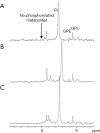Molecular imaging of tumors by chemical exchange saturation transfer MRI of glucose analogs
- PMID: 31728315
- PMCID: PMC6828577
- DOI: 10.21037/qims.2019.09.12
Molecular imaging of tumors by chemical exchange saturation transfer MRI of glucose analogs
Abstract
Early detection of the cancerous process would benefit greatly from imaging at the cellular and molecular level. Increased glucose demand has been recognized as one of the hallmarks of cancerous cells (the "Warburg effect"), hence glucose and its analogs are commonly used for cancer imaging. One example is FDG-PET technique, that led to the use of chemical exchange saturation transfer (CEST) MRI of glucose ("glucoCEST") for tumor imaging. This technique combines high-resolution MRI obtained by conventional imaging with simultaneous molecular information obtained from the exploitation of agents with exchangeable protons from amine, amide or hydroxyl residues with the water signal. In the case of glucoCEST, these agents are based on glucose or its analogs. Recently, preclinical glucoCEST studies demonstrated the ability to increase the sensitivity of MRI to the level of metabolic activity, enabling identification of tumor staging, biologic potential, treatment planning, therapy response and local recurrence, in addition to guiding target biopsy for clinically suspected cancer. However, natural glucose limits this method because of its rapid conversion to lactic acid, leading to reduced CEST effect and short signal duration. For that reason, a variety of glucose analogs have been tested as alternatives to the original glucoCEST. This review discusses the merits of these analogs, including new data on glucose analogs heretofore not reported in the literature. This summarized preclinical data may help strengthen the translation of CEST MRI of glucose analogs into the clinic, improving cancer imaging to enable early intervention without the need for invasive techniques. The data should also broaden our knowledge of fundamental biological processes.
Keywords: Cancer; MRI; chemical exchange saturation transfer (CEST); contrast agent; diagnosis; molecular imaging.
2019 Quantitative Imaging in Medicine and Surgery. All rights reserved.
Conflict of interest statement
Conflicts of Interest: M.R. and G.N. are the inventors listed on patents that develop glucose analogs for CEST MRI techniques: WO-2015145447-A3 and WO2017090047A1.
Figures










Similar articles
-
A rapid and systematic review of the clinical effectiveness and cost-effectiveness of paclitaxel, docetaxel, gemcitabine and vinorelbine in non-small-cell lung cancer.Health Technol Assess. 2001;5(32):1-195. doi: 10.3310/hta5320. Health Technol Assess. 2001. PMID: 12065068
-
Cost-effectiveness of using prognostic information to select women with breast cancer for adjuvant systemic therapy.Health Technol Assess. 2006 Sep;10(34):iii-iv, ix-xi, 1-204. doi: 10.3310/hta10340. Health Technol Assess. 2006. PMID: 16959170
-
Signs and symptoms to determine if a patient presenting in primary care or hospital outpatient settings has COVID-19.Cochrane Database Syst Rev. 2022 May 20;5(5):CD013665. doi: 10.1002/14651858.CD013665.pub3. Cochrane Database Syst Rev. 2022. PMID: 35593186 Free PMC article.
-
Home treatment for mental health problems: a systematic review.Health Technol Assess. 2001;5(15):1-139. doi: 10.3310/hta5150. Health Technol Assess. 2001. PMID: 11532236
-
NIH Consensus Statement on Management of Hepatitis C: 2002.NIH Consens State Sci Statements. 2002 Jun 10-12;19(3):1-46. NIH Consens State Sci Statements. 2002. PMID: 14768714
Cited by
-
Characterization of 18F-fluorodeoxyglucose metabolic spatial distribution improves the differential diagnosis of indeterminate pulmonary nodules and masses with high fluorodeoxyglucose uptake.Quant Imaging Med Surg. 2021 Apr;11(4):1543-1553. doi: 10.21037/qims-20-768. Quant Imaging Med Surg. 2021. PMID: 33816190 Free PMC article.
-
Advances in application of novel magnetic resonance imaging technologies in liver disease diagnosis.World J Gastroenterol. 2023 Jul 28;29(28):4384-4396. doi: 10.3748/wjg.v29.i28.4384. World J Gastroenterol. 2023. PMID: 37576700 Free PMC article. Review.
-
Dynamic contrast-enhanced CEST MRI using a low molecular weight dextran.NMR Biomed. 2022 Mar;35(3):e4649. doi: 10.1002/nbm.4649. Epub 2021 Nov 15. NMR Biomed. 2022. PMID: 34779550 Free PMC article.
-
Deuterium Metabolic Imaging-Rediscovery of a Spectroscopic Tool.Metabolites. 2021 Aug 25;11(9):570. doi: 10.3390/metabo11090570. Metabolites. 2021. PMID: 34564385 Free PMC article. Review.
-
Radiofrequency labeling strategies in chemical exchange saturation transfer MRI.NMR Biomed. 2023 Jun;36(6):e4944. doi: 10.1002/nbm.4944. Epub 2023 Apr 27. NMR Biomed. 2023. PMID: 37002814 Free PMC article. Review.
References
-
- Larson SM. F-18-FDG imaging: Molecular or functional? J Nuc Med 2006;47:31-2.
-
- Kelloff GJ, Hoffman JM, Johnson B, Scher HI, Siegel BA, Cheng EY, Cheson BD, O'shaughnessy J, Guyton KZ, Mankoff DA, Shankar L, Larson SM, Sigman CC, Schilsky RL, Sullivan DC. Progress and Promise of FDG-PET Imaging for Cancer Patient Management and Oncologic Drug Development. Clin Cancer Res 2005;11:2785-808. 10.1158/1078-0432.CCR-04-2626 - DOI - PubMed
-
- Belhocine T, Spaepen K, Dusart M, Castaigne C, Muylle K, Bourgeois P, Bourgeois D, Dierickx L, Flamen P. 18FDG PET in oncology: the best and the worst. Int J Oncol 2006;28:1249-61. - PubMed
Publication types
LinkOut - more resources
Full Text Sources
